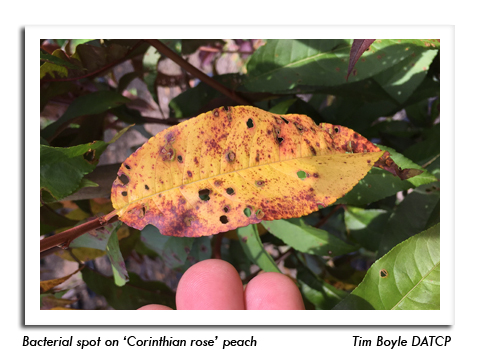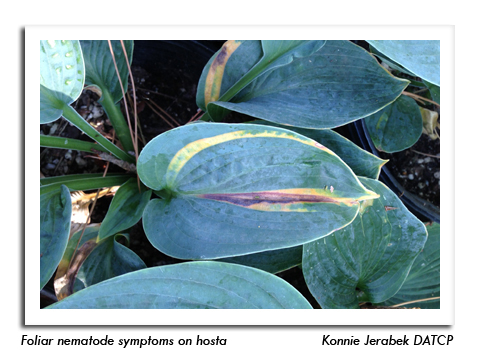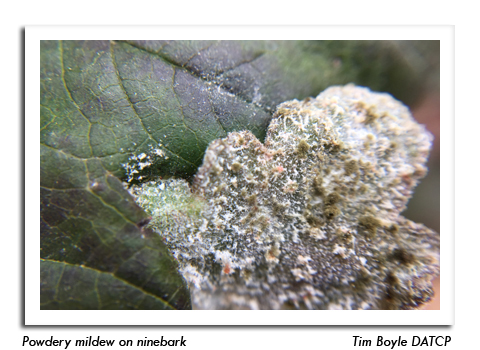
 |
|
|
Nursery & Forest
Volume 64 Number 17 Date 08/22/2019 BACTERIAL LEAF SPOT - Symptoms of this disease, also known as "bacterial shot hole," were noted on 'Corinthian Rose' ornamental shrub peach trees at a central Wisconsin grower this week. The angular purple-brown spots appear on the foliage as the disease begins, and soon the center of the lesions fall out, giving the leaves a "shot hole" appearance. Bacterial spot pathogens overwinter inside bark cracks and in leaf scars that were infected during the previous season. As budding begins, the bacteria multiply and spread from the cankers via dripping dew, rain splash, or wind. Severe bacterial fruit tree infections occur most frequently when excessive rainfall combines with high humidity, especially in trees on light, sandy soil or those suffering other stressors. The disease results in overall physiological malaise from recurrent defoliation, reduced fruit production, and weakened trees that are more susceptible to winter injury. Best management practices include keeping trees healthy by properly pruning out diseased or dead limbs and only fertilizing and watering as necessary, as too much nitrogen can aggravate the disease. Though preventative chemical sprays with copper-based bactericide and antibiotic oxytetracycline can be beneficial, the best long term control is to seek out and plant resistant cultivars. FOLIAR NEMATODE - The necrotic leaf streaks indicative of infestation from microscopic roundworms known as foliar nematodes (Aphelenchoides sp.) were found on several cultivars of anemone, hosta and stachys at multiple growers in Kenosha, Walworth, and Waukesha counties this month. Typically, leaf discoloration initially appears in June and becomes more noticeable in late summer as the necrotic streaks develop. Foliar nematodes are spread by water splashing among infected hosts and through vegetative propagation (from a fragment of an infected parent plant or a specialized reproductive tissue), and as a result are becoming an increasingly common pest in the nursery trade. Infested plants sometimes appear symptomless until the nematode populations grow very high, causing serious problems for growers and in display plantings. Although they rarely kill their host, foliar nematodes reduce overall vigor and can make plants unsightly and unmarketable. Replanting susceptible stock in areas recently infested with nematodes should be avoided since the nematodes can temporarily survive in soil. Cuttings from infected stock should never be used for propagation, and decontamination of tools following contact with plants suspected of being infected is good practice. Chemical control is not effective against this pest. POWDERY MILDEW - This fungal disease has been especially prevalent on Wisconsin nursery stock this season. Powdery mildew occurs on the upper and (less frequently) lower surfaces of leaves, as well as the stems, giving plants a white, powdery appearance. Caused by several closely-related, primarily host-specific fungi that survive in plant debris or on infected plants, powdery mildew is usually cosmetic and non-lethal for many trees and shrubs. However, on plants such as ninebark, powdery mildew can result in severe leaf loss and branch tip dieback. JAPANESE BEETLE - Japanese beetle feeding and mating activity continues to be high on fruit trees, lindens, and ornamental plants at nursery growers in central and southern Wisconsin. Control of adult beetles is difficult. Insecticides may reduce beetle numbers and damage, but applications often need to be repeated every 3-4 days since new migrations of beetles can occur daily. Physically removing beetles or protecting valuable plants with floating row covers is the recommended control measure for small areas. Dropping the beetles into a container of soapy water will eliminate the aggregation pheromone released to attract more beetles. -- Tim Boyle, DATCP Nursery Inspector 



|
|
|